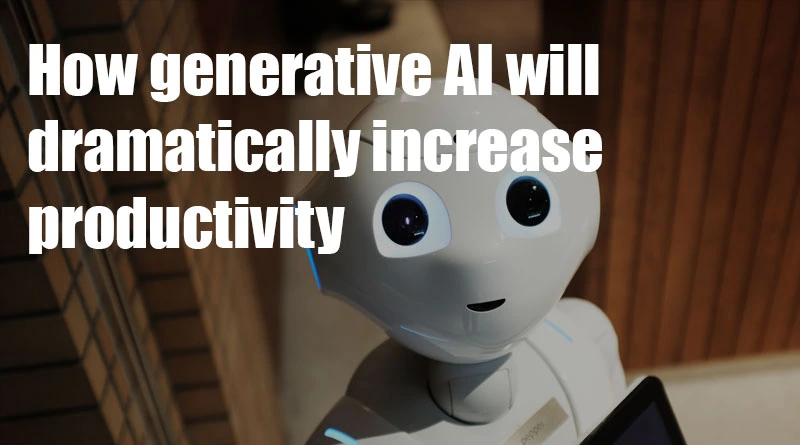Many employment won’t be eliminated by generative technology; instead, they will change.
Imagine a journalist who could write six times as quickly and succinctly as Michael Lewis.
Imagine a video editor taking 15 minutes to select the best 15-second snippets from five hours of video content.
Imagine software developers writing code in their organization’s style with the help of an AI helper to double their productivity.
Today, this is starting to take place. With generative technology, which allows artificial intelligences to collaborate with people and increase productivity, you can have a team of four to assist you out instantly and inexpensively.
If you could duplicate yourself, what would you do? In essence, it is what generative technology is accomplishing. We ought to all benefit from it.
While a 20% increase in productivity is referred to as “progress,” a tenfold increase in productivity—which is what generative technology can do—is more like a revolution.
The majority of sectors you can conceive of, such as education, marketing, journalism, software development, and design, will be transformed by generative technology. You may already be familiar with generative technology solutions like Midjourney for art, ChatGPT for text and search, and CodeT5 for software development.
And this technology will be widely used within the upcoming 12 months. We have met with more than 100 founding teams working in this field and are monitoring more than 500 generative tech firms. Naturally, Big Tech is also developing generative technology.
Here are some predictions for the upcoming months as we continue to learn more about the generative tech environment.
1-USER-FRIENDLY APPLICATIONS ARE SURGEING:
I use the term “generative tech” rather than “generative AI” since AI is merely one component—the base layer of the tech stack. The partnership between humans and AI will actually be seen in the application layer on top. In the next two years, tens of thousands of these applications will be developed across all industries. These are the workflow tools that result in output that is greatly increased. We’ve already made investments in AI-driven products for the coding and legal sectors in just our portfolio (Darrow, TermScout) (The.com). There may be an unlimited number of choices as well.
2-A TECHNOLOGY CONSUMER RESURGENCE:
Over the following ten years, consumer technology will experience a rebirth, with a flood of new decacorn enterprises emerging from generative tech applications. Over the previous ten years, B2B enterprises have largely taken the limelight and profits, but the transition to generative technology will start to swing the balance back. This area is so intriguing in part because it has the potential to help people in ways that haven’t been seen since the invention of the smartphone. The online excitement created by products like Descript’s video editing tool, OpenAI’s ChatGPT, and others like it demonstrates just how much the generative technology revolution can help customers.
3-A shift from creation to curation:
With generative technology, we will finally have the means to get from nothing to something, which will make creation simpler than ever. I anticipate seeing more of everything as we increasingly rely on artificial intelligence for creativity.
More words. extra video more sound more pictures Then, how users modify, hone, curate, and master these tools will be more and more crucial.
The value of the artist’s distinctive eye will remain. The AI’s draught copy can still be edited and improved by writers to reflect their unique voices. Simply put, they’ll be more effective, quicker, and better at their professions, which will free up more time for curation.
It goes without saying that since this is a revolution, instability is a risk.
Many people will be concerned that AI might steal their jobs, change who they are, and lower their social standing. Apprehension is normal when new technology emerges since skilled workers have spent years mastering what ChatGPT, CodeT5, and Midjourney can achieve in a matter of seconds.
Since the 1990s, when the tech industry was experiencing a frenzied period of newness, I have witnessed numerous waves of anxiety emerge.
This is the “life cycle of uncomfortable tech,” in my opinion. First, they mock the new technology and treat it like a foolish toy. Second, it is criticised. They fear it, thirdly. Finally, they embrace it and participate in it. It just takes time.
The unsettling news regarding generative technology? It will alter how people operate and produce things. the positive news Few professions will be lost; instead, they will just develop.
It will also open up new career paths and professions that we hadn’t considered. Further still, in regions where a firm previously couldn’t afford brilliant writers or designers, the general calibre of the content and design we see will improve.
Simply said, I believe there is no justification for opposing generative technology. It has already arrived and is in progress. However, you can get a head start and learn how to use modern technologies to your advantage and improve your career.
In the following 36 months, those who adopt generative technology will experience notable increases in their productivity.
These professionals will work in a wide range of fields, including marketing, sales, writing, education, law, investment banking, data science, art, video game creation, TV and film, book publishing, periodicals, news, real estate, software programming, and recruiting. Unfortunately, there is no question that the volume and sophistication of online spam and misinformation will likewise rise. To overcome this, both businesses and users will need to collaborate.
By using generative technology software, which provides access to underlying AI models simple to use and simple to incorporate into our workflows, we will be able to achieve these productivity explosions. In the same way that teams utilise Slack, Salesforce, or HubSpot now, we will need software that enables collaboration with others in the workplace.
The next three years are going to be exciting.
